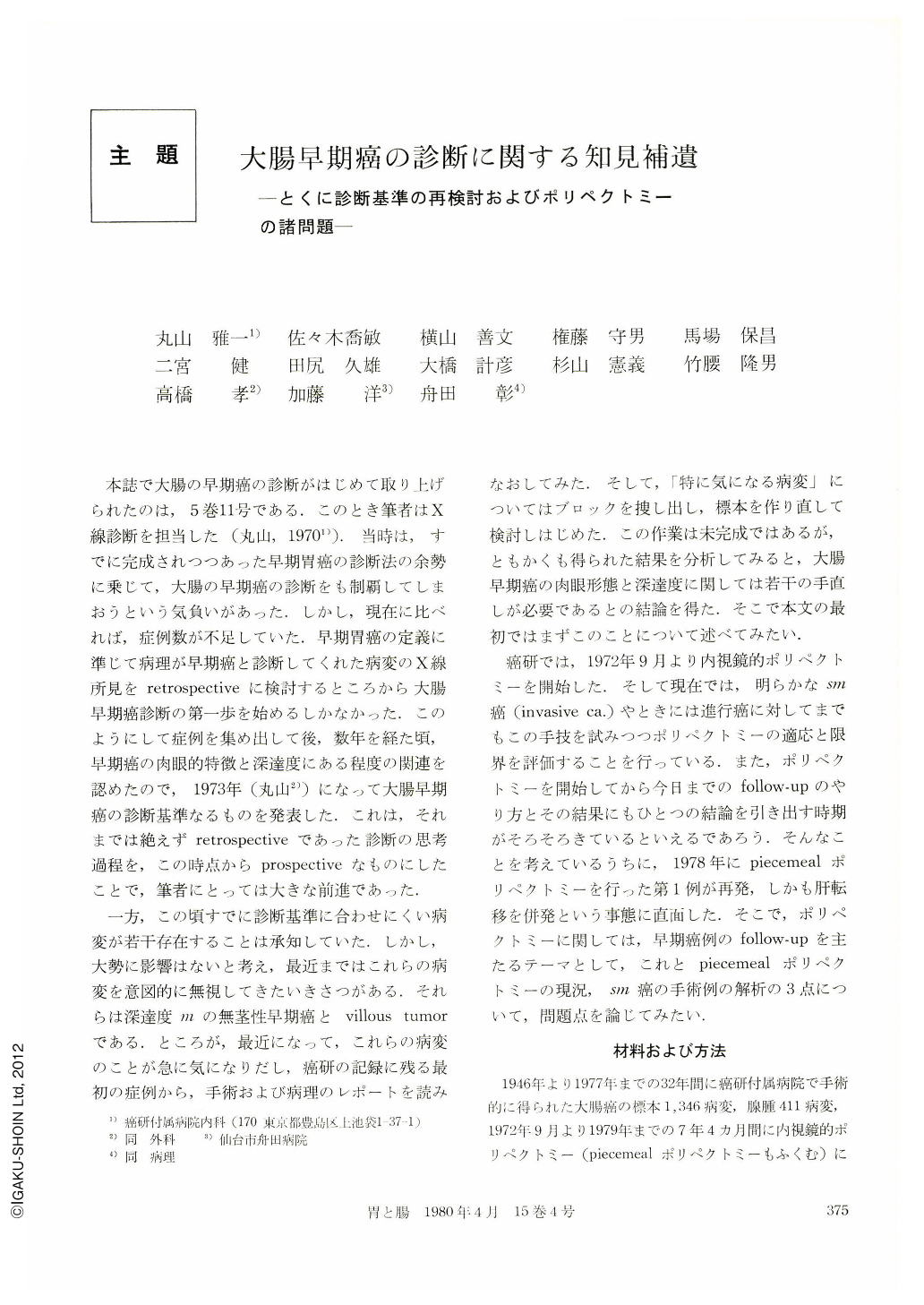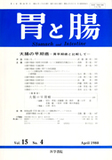Japanese
English
- 有料閲覧
- Abstract 文献概要
- 1ページ目 Look Inside
本誌で大腸の早期癌の診断がはじめて取り上げられたのは,5巻11号である.このとき筆者はX線診断を担当した(丸山,19701)).当時は,すでに完成されつつあった早期胃癌の診断法の余勢に乗じて,大腸の早期癌の診断をも制覇してしまおうという気負いがあった.しかし,現在に比べれば,症例数が不足していた.早期胃癌の定義に準じて病理が早期癌と診断してくれた病変のX線所見をretrospectiveに検討するところから大腸早期癌診断の第一歩を始めるしかなかった.このようにして症例を集め出して後,数年を経た頃,早期癌の肉眼的特徴と深達度にある程度の関連を認めたので,1973年(丸山2))になって大腸早期癌の診断基準なるものを発表した.これは,それまでは絶えずretrospectiveであった診断の思考過程を,この時点からprospectiveなものにしたことで,筆者にとっては大きな前進であった.
一方,この頃すでに診断基準に合わせにくい病変が若干存在することは承知していた.しかし,大勢に影響はないと考え,最近まではこれらの病変を意図的に無視してきたいきさつがある.それらは深達度mの無茎性早期癌とvillous tumorである.ところが,最近になって,これらの病変のことが急に気になりだし,癌研の記録に残る最初の症例から,手術および病理のレポートを読みなおしてみた.そして,「特に気になる病変」についてはブロックを捜し出し,標本を作り直して検討しはじめた.この作業は未完成ではあるが,ともかくも得られた結果を分析してみると,大腸早期癌の肉眼形態と深達度に関しては若干の手直しが必要であるとの結論を得た.そこで本文の最初ではまずこのことにっいて述べてみたい.
The diagnostic criteria for early cancer of the large bowel was reevaluated, based on 1,346 lesions of cancer and 411 lesions of adenoma which had been operated upon in a period of 32 years from 1946 to 1977 at the Cancer Institute Hospital. Then some problems on endoscopic polypectorny of the large bowel were discussed in association with the abovementioned study, based On 362 lesions which had been polypectomized in a period of 7 years and 4 months from September 1972 to 1979.
It was revealed that there was no necessity for changing the diagnostic criteria for pedunculated early cancer.
Cancer with submucosal invasion as well as mucosal cancer was most frequent on the level of 10 mm in the pedunculated lesions. This fact shows marked difference from the characteristics of gastric polypoid lesions in which incidence of malignancy is higher as their size becomes larger.
Following the former criteria, a sessile lesion on a 10 mm level could be most probably diagnosed as a cancer with submucosal invasion. However, it was indicated by the reevaluation study that this criteria should inevitably be changed due to a presence of mucosal cancer (25.0%) on 10 mm level. In other words, we have to take note of the fact that there is a chance of mucosal cancer in a sessile lesion with the size of 10 mm level. This type of lesion is found to be associated with multiple cancers in most cases, and suggests a possibility of cancer de novo. Although only one case was clinically discovered before surgery, an effort should be made to discover it, especially for critical evaluation on adenoma-cancer sequence.
Sessile early cancers larger than 40 mm are villous tumors in most cases. In this paper all villous tumors were regarded to be malignant in their nature, because villous configuration itself may be an extermity of constructual atypism, regardless of cellular atypism. In doing so, we come to a tentative settlement of a problem that in the macroscopic diagnosis it is cult to estimate invasion depth of malignant villous tumor.
As with the endoscopic polypectomy, present condition of selective follow-up examination was first considered. We have made it a rule to do the first follow-up examination within 3 months after the polypectomy and to do the further study in every 6 to 12 months after the first follow-up examination. Actually it was revealed that the first follow-up examination had been performed satisfactorily, but that the further examination was performed at random. In order to perform selective follow-up examination strictly it is necessary to persuade the patients of its importance repeatedly.
Indication of piecemeal polypectomy should be considered very carefully. It may be indicated for a lesion to which it is technically done, but further coiectomy should he indispensable within 13 months if cancer is exposed to the cut surface of retrieved materials. We have experienced a case of recurrence with liver metastasis in a series of the piecemeal polypectomy which was discovered in 346 days after the second follow-up examination at which biopsy from the polypectomized site, an ulcer scar, was negative for cancer.
Cancer with submucosal invasion (sm-ca., invasive ca.) should be colectnmized within 3 months except for the patients with senility or poor risk, because at the present time it is difiicult to clarify the exceptional condition in which lymph node metastasis takes place.
Now, there exists a contradiction why endoscopic polypectomy is to be performed to a lesion which in the light of present diagnositic criteria by radiology and endoscopy can be definitely diagnosed as a cancer with submucosal invasion.

Copyright © 1980, Igaku-Shoin Ltd. All rights reserved.


